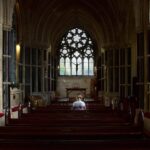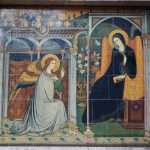Lord, To Whom Shall We Go?
by Cardinal Timothy M. Dolan
On Monday, February 11, the feast of Our Lady of Lourdes, news arrived from Rome that that has not been heard since decades before Columbus sailed for the new world: The Holy Father had renounced his office, declaring that the See of Peter would be vacant on February 28. This news was startling. While a papal resignation is foreseen in canon law, the Catholic imagination is stretched by it. I am grateful for Pope Benedict XVI’s lifetime of service to the Church, and admire his humility in voluntarily relinquishing his ministry as Bishop of Rome. At the same time, I know that many Catholics have found the news unsettling. All of us are attached to the Holy Father, the universal shepherd of the earthly flock. Our hearts are therefore full of many sentiments, and with these reflections I invite you to consider how we might receive this news in the light of Christ Jesus, our unique Savior, our great High Priest, the Supreme Pastor of the Church.
A Special Day of Prayer
We began Lent last week on Ash Wednesday, and the Church’s liturgy gave us the words of the prophet Joel, inviting us to return to the Lord with all our heart (Joel 2:12-13). Pope Benedict himself made those words the centerpiece of his homily that day: “This ‘return to me with all your heart,’ then, is a reminder that not only involves the individual but the entire community.”
In these days of novelty and uncertainty, when many may be anxious and nervous, we need more than ever to return to the Lord, as individuals and together as the Church. That is why I have asked every parish in the Archdiocese of New York to participate in a novena, nine days of special prayer, between February 20 and February 28, to offer to God our gratitude for the blessing that Pope Benedict has been to the Church, peace and good health in his remaining days, and God’s guidance as we await his successor. I have also asked that tomorrow, February 22, the Feast of the Chair of Saint Peter, we remember Pope Benedict in a special way with special Masses and Eucharistic adoration.
Feast of the Chair of Saint Peter
This Feast of the Chair of Saint Peter is the liturgical feast of the office of Peter in the Church. It commemorates Peter’s role as the head of the apostles, the one designated by Jesus Christ to be the universal pastor of the entire Church. Just as here in the Archdiocese of New York, Saint Patrick’s Cathedral is the place of the bishop’s cathedra, or chair, the symbol of his authority and mission, so too the feast of Peter’s chair marks the Holy Father’s authority and mission for the Church universal.
It is a suitable feast to give thanks for the gift of Peter’s mission in the Church, carried out from the time of Jesus to our own day by Peter and his successors. The news of Pope Benedict stepping down from his office was a powerful reminder of how ancient this office is, given that what we are experiencing has not happened for more than half a millennium! The news invited us to look back over the history of the See of Peter, which has navigated more than a few storms in her path through history. That in 2013 the Church is preparing to receive a new successor of Peter in peace and serenity is not to be taken for granted. The papacy is not to be taken for granted. Even secular historians marvel at the papacy’s endurance; the eyes of faith see in that a testimony to the Holy Spirit’s guidance of the Church, from the day that Peter himself preached on that first Pentecost to today.
We need Peter among us. Without the charism of Peter in the Church, we would be tossed about by every gust of wind, every false doctrine, every silly trend (cf. Ephesians 4:14). Today we know that all too well. It was Cardinal Joseph Ratzinger, on the day before his own election as Bishop of Rome, who warned us about the “dictatorship of relativism,” in preaching on that very passage from St. Paul. The “dictatorship of relativism” rebels against authority and flounders about in a world of nihilism. The Christian soul earnestly seeks the authority of Christ, of His Gospel, of His Church, and of His Vicar on earth.
Peter is the gift of Jesus to the Church, a teacher to hand on the deposit of the faith, and to be a sign of unity. Ubi Petrus, ibi ecclesia—Where Peter is, there is the Church—as the ancient expression puts it. From the Acts of the Apostles to World Youth Day, Catholics of every time and place have recognized the gift of Peter and his successors in their midst. This archdiocese experienced this in a powerful way when Pope Benedict made a pastoral visit here in 2008, celebrating Mass in Saint Patrick’s Cathedral and Yankee Stadium, praying at Ground Zero, and uniting with our Jewish neighbors, our disabled, and with our young people, at Saint Joseph’s Seminary.
Last year, the Pope chose the Feast of the Chair of Saint Peter as the day for the consistory in which others and I were created cardinals. He wished to emphasize the responsibility of the cardinals to protect the gift of Peter in the Church. This is most evident when they gather in the conclave to renew the gift of Peter by electing a new pope. Yet it is also an ongoing task, to collaborate with the Holy Father in his ministry, and to lead the entire Christian people in praying for Peter, in listening to Peter, in following Peter, and in loving Peter. Soon we will have a new Pope to pray for, to listen to, to follow, and to love. Precisely because we prayed for him, because he was so marvelous to listen to, because he was so gentle to follow, because we loved him so much—for all these reasons and more it will be very difficult when Pope Benedict takes his leave from us. There will be many tears on February 28, 8 p.m., Rome time—not just among the cardinals who will bid him farewell, but among people the world over.
Upon this rock I will build my Church
It was the will of the Lord Jesus to build His Church upon the rock of Peter, after his confession of faith at Caesarea Philippi (cf. Matthew 16:18). Throughout all the twists and turns of history, the Church has remained faithful to the primacy of Peter, which is testified to repeatedly in the New Testament and in the teaching of the Fathers of the Church. These teachings were confirmed by the Second Vatican Council. At the same time as these doctrines were taught, the mass media age made the figure of the Holy Father more immediately present in the lives of Catholics. Those of us who grew up in the 1950s remember that portraits of the Pope Pius XII were in every Catholic parish and school, and we were able to listen to his voice on radio broadcasts, and see him on newsreels. Blessed John XXIII began papal travels in Italy, and Pope Paul VI extended that to the very ends of the earth. With Blessed John Paul II and Pope Benedict, it became a routine expectation that the Holy Father would visit us, and the Internet made their words immediately available to us.
All of this has increased the profile of the Pope in the lives of Catholics. Consequently, many Catholics found themselves somewhat adrift, perhaps even feeling abandoned, by the news of last Monday. Was the rock of Peter suddenly less stable? To them I would like to address a few words. As much as we love the Holy Father, Benedict himself reminded us this week that it is Christ Jesus who remains always the Supreme Pastor of the Church. Popes, bishops, parish priests—yes, even cardinals—all come and go; Jesus alone remains. Peter is the rock to be sure, but it is the Lord Jesus who is the cornerstone and the sure foundation of the Church. The news of this past week should be a reminder of that.
All of us who witnessed the last years of Blessed John Paul II may have been surprised that Benedict would relinquish the office that his predecessor lived out until he was stripped even of his ability to speak. Pope Benedict’s announcement on the feast of Our Lady of Lourdes called to mind the last foreign visit by Blessed John Paul II, which was to Lourdes itself in August 2004. It was an occasion of deep emotion, as he spoke of himself as a sick man among the sick. Pope Benedict has chosen, “after repeatedly examining my conscience before God,” a different path. Catholics ought not be distressed by that, as if one choice implies that something is lacking in the other. Holiness is not uniformity, and the history of the Church provides many examples of holy men and women taking different decisions—think of Peter and Paul, Augustine and Jerome, Ignatius and Philip Neri, or Mother Theresa and Dorothy Day. Even the saints come to different conclusions, and different circumstances require different responses. So it is possible to recall with admiration the decision of Blessed John Paul II to suffer to the end, and, at the same time, to admire Pope Benedict’s humility and courage in laying down, for the good of the Church, the office entrusted to him. And if we remain puzzled as to the will of God in these decisions, then that too can be a gift, for there is nothing more important than to reflect upon the will of God.
I would further add that the personal qualities of Pope Benedict ought to inspire confidence in his decision. He is deeply immersed in the Holy Scriptures and the wisdom of the Fathers, he knows the Catholic tradition better than almost anyone, and he is a disciple who has made heroic sacrifices to serve the Church as she wanted, not as he wanted, first as a bishop and later as pope. Above all, he has a deep friendship with Jesus. All of that should, for those who are unsettled, be a source of confidence and comfort. The gift of Peter in the Church does not mean that each individual successor of Peter corresponds to that gift. But in the popes of recent times, above all in Blessed John Paul II and in Pope Benedict, the whole world has seen transparent holiness. We can trust that.
Strengthening the brethren
When Blessed John Paul II spoke of his Petrine office, he most often referred not to the biblical scene at Caesarea Philippi—a high point in Peter’s life—but of the scene at the trial of Jesus in the house of the high priest – a low point in Peter’s life, the night of the triplex denial. Jesus tells Peter that Satan has demanded to sift all of them like wheat, but that Jesus has prayed for Peter, that his faith may not fail, and when he has turned back to Jesus, his mission will be to strengthen his brothers in the faith (Luke 22:32). That scene, in which our heart breaks for both Jesus and Peter on the night of the denials, reminds us that Peter’s mission of strengthening us in the faith is granted to him not because of his own virtues, but because of the prayer of Jesus Himself.
Pope Benedict told us that he no longer has the necessary strength to continue his mission of strengthening the faithful. That decision matured as the fruit of his prayer. The Holy Father knows that the mission given to Peter on the night of the denials must continue and cannot be left aside. And if he lacks the strength to do so himself, then another must take it up.
Simon, son of John, do you love me?
The night of the triplex denial is reversed at dawn on the Sea of Galilee. Jesus asks Peter three times about his love, and Peter responds with humble contrition: Lord, you know all things, you know that I love you (cf. John 21). Every vocation in the Church is an invitation to love, and to love means sacrifice for the sake of the beloved. The path of love leads to the Cross, which is why every vocation is accompanied by the Lord’s exhortation to be not afraid.
In these Lenten days we need to pray and offer penance for the man who will be the new successor of Peter among us. That man will soon be asked a question both awesome and awful: Do you accept your election? The world may regard those words as a triumph of sorts, but they are put in the Sistine Chapel to a man who knows that they are invitation to walk a via Crucis. Pope Benedict referred to those words as an “ax” that fell upon his neck.
Lord, to whom shall we go?
At a critical moment in His preaching ministry, Jesus teaches the people about the Eucharist. After the “bread of life” discourse at the synagogue in Capernaum (cf. John 6), many of His disciples decided to follow Him no longer. Jesus asks the apostles whether they too would like to go away. Peter gives a beautiful response: Lord, to whom shall we go? You alone have the words of eternal life!
I chose those words for my episcopal motto—Ad quem ibimus? To whom shall we go? When I was told that Blessed John Paul II had chosen me to be a bishop I went to the chapel to pray, and those words came immediately to my heart. In the face of difficulties, in face of uncertainty, in the face of unexpected missions, the Christian disciple always has the response of Peter for inspiration: Lord, to whom shall we go?
A year ago, when I was created a cardinal, I knew in theory that one day a conclave would come. Now it is a reality, and I ask your prayers for me as your archbishop that I might be an instrument of the Lord’s grace and providence in the days ahead.
In the conclave the cardinals cast their ballots by placing them in a chalice on the altar of the Sistine Chapel. Above the altar is the great fresco of Michelangelo, the Last Judgment. So each cardinal as he ascends the steps to cast his ballot has before his eyes the immense figure of Christ the Judge. The cardinals literally have to go toward the Lord Jesus at this solemn moment. It is our task in these days to go to the Lord more frequently and more insistently in our prayer. Lord, to whom shall we go? There will be many other voices, from the world, and even from enemies of the Church, offering advice on how we should conduct ourselves in the conclave. I ask you to pray for me that, in the midst of all the conflicting voices, I go to the Lord Himself, ascending those steps in a way that will be pleasing to Him on the day of my death and judgment.
With my anticipated gratitude for your generous response to my invitation, I conclude with a succinct Latin prayer that expresses well what it is in our hearts in these days. Omnes cum Petro, ad Jesum per Mariam. All with Peter, to Jesus through Mary!





